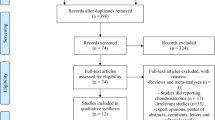Abstract
Objective
Cartilage invasion in laryngohypopharyngeal cancer has a significant impact on the choice of treatment modality and outcome of the disease. We examined invasion of cartilage in laryngohypopharyngeal cancer by simultaneous bone and tumor dual-isotope SPECT using99mTc-hydroxymethylene diphosphonate and20lTl-chloride.
Methods
Early and delayed simultaneous bone and tumor dual-isotope SPECT were performed on 19 patients with laryngohypopharyngeal cancer. Dual-isotope SPECT images were superimposed to project tumor location from tumor SPECT onto the osseous structures shown by bone SPECT. The presence or absence of cartilage invasion was evaluated histopathologically or by radiological studies such as CT and/or MRI.
Results
Histopathological or radiological examination of the cartilage revealed invasion in 5 patients and no invasion in 14 patients. The results of both early and delayed dual-isotope SPECT were exactly the same. Using dual-isotope SPECT, the sensitivity, specificity, and accuracy in detecting cartilage invasion by laryngohypopharyngeal cancer were: 80% (4/5), 92.9% (13/14), and 89.5% (17/19), respectively.
Conclusions
Results of the present study suggest that superimposed early bone and tumor dual-isotope SPECT images may be sufficient for the diagnostic evaluation of cartilage invasion by laryngohypopharyngeal cancer. Superimposed dual-isotope SPECT imaging is a useful technique in the evaluation of cartilage invasion in laryngohypopharyngeal cancer.
Similar content being viewed by others
References
Becker M, Schroth G, Zbaren P, Delavelle J, Greiner R, Vock P, et al. Long-term changes induced by high-dose irradiation of the head and neck region: imaging findings.RadioGraphics 1997; 17:5–26.
Castelijns JA, Becker M, Hermans R. The impact of cartilage invasion on treatment and prognosis of laryngeal cancer.Eur Radiol 1996; 6:156–169.
Curtin HD. Imaging of the larynx: Current concepts.Radiology 1989; 173:1–11.
Curtin HD. The importance of imaging demonstration of neoplastic invasion of laryngeal cartilage.Radiology 1995; 194:643–644.
Castelijns JA, van den Brekel MWM, Tobi H, Smit EM, Golding RP, van Schaik C, et al. Laryngeal carcinoma after radiation therapy: correlation of abnormal MR imaging signal patterns in laryngeal cartilage with the risk of recurrence.Radiology 1996; 198:151–155.
Wolf GT. Induction chemotherapy plus radiation compared with surgery plus radiation in patients with advanced laryngeal cancer.N Engl J Med 1991; 324:1685–1690.
UICC International Union Against Cancer. TNM Classification of Malignant Tumors. Sobin LH, Wittekind CH, eds.Head and Neck Tumors. 5th ed. New York; John Wiley & Sons, 1997.
Atula T, Markkola A, Leivo I, Makitie A. Cartilage invasion of laryngeal cancer detected by magnetic resonance imaging.Eur Arch Otorhinolaryngol 2001; 258:272–275.
Becker M, Zbaren P, Laeng H, Stoupis C, Porcellini B, Vock P. Neoplastic invasion of the laryngeal cartilage: comparison of MR imaging and CT with histopathologic correlation.Radiology 1995; 194:661–669.
Almeida F, Yen CK, Lull RJ, Lim AD. Technetium-99m-MDP uptake in thyroid cartilage in invasion squamous-cell laryngeal carcinoma.J Nucl Med 1994; 35:1170–1173.
Chan KW, Merrick MV, Mitchell R. Bone SPECT to assess mandibular invasion by intraoral squamous cell carcinoma.J Nucl Med 1996; 37:42–45.
Nishiyama Y, Kawasaki Y, Yamamoto Y, Fukunaga K, Satoh K, Takashima H, et al. Technetium-99m-MIBI and thallium-201 scintigraphy of primary lung cancer.J Nucl Med 1997; 38:1358–1361.
Nishiyama Y, Yamamoto Y, Fukunaga K, Kiuchi T, Satoh K, Takashima H, et al. Evaluation of radiotherapeutic response in non-small cell lung cancer patients by techne-tium-99m MIBI and thallium-201 chloride SPET.Eur J Nucl Med 2000; 27:536–541.
Nishiyama Y, Yamamoto Y, Ono Y, Takahashi K, Nakano S, Satoh K, et al. Comparison of99Tcm-tetrofosmin withand 131I in the detection of differentiated thyroid cancer metastases.Nucl Med Commun 2000; 21:917–923.
Yamamoto Y, Nishiyama Y, Toyama Y, Ohbayashi Y, Iwasaki A, Satoh K, et al. Comparison of201Tl with67Ga single photon emission tomography in the diagnosis of head and neck cancer recurrence.Nucl Med Commun 2002; 23:187–191.
Fukumoto M, Yoshida S, Yoshida D, Kishimoto S. Dualisotope SPECT of skull-base invasion of head and neck tumors.J Nucl Med 1995; 36:1740–1746.
Yamamoto Y, Kusuhara T, Y, Kumazawa Y, Nishiyama Y, Takashima H, Ohkawa M, et al. The effect of scattering in simultaneous acquisitions of Tc-99m and I-201: a fundamental study through phantom experiments.Radioisotopes 1996; 45:369–374.
Yamamoto Y, Nishiyama Y, Satoh K, Ohbayashi Y, Iwasaki A, Miyabe K, et al. Dual-isotope SPECT using99mTc- hydroxymethylene diphosphonate and20lTl-chloride to assess mandibular invasion by intraoral squamous cell carcinoma.J Nucl Med 2002; 43:1464–1468.
Glaser Pruckmayer M, Staudenherz A, Rasse M, Lang S, Leitha T. Utility of99mTc-sestamibi in the assessment of osseous tumor spread.J Nucl Med 1996; 37:1526–1528.
Israel O, Jerushalmi J, Frenkel A, Kuten A, Front D. Normal and abnormal single photon emission computed tomography of the skull: comparison with planar scintigraphy.J Nucl Med 1988; 29:1341–1346.
Leitha T, Glaser Pruckmayer M, Rasse M, Millesi W, Lang S, et al. Technetium-99m-MIBI in primary and recurrent head and neck tumor: contribution of bone SPECT image fusion.J Nucl Med 1998; 39:1166–1171.
Gregor TR, Hammond Framework invasion by laryngeal carcinoma.Am J Surg 1987; 154:452–457.
Harrison DFN, Denny S. Ossification within the primate larynx.Acta Otolaryngol 1983; 95:440–446.
Author information
Authors and Affiliations
Corresponding author
Rights and permissions
About this article
Cite this article
Nishiyama, Y., Yamamoto, Y., Yokoe, K. et al. Superimposed dual-isotope SPECT using99mTc-hydroxymethylene diphosphonate and201Tl-chloride to assess cartilage invasion in laryngohypopharyngeal cancer. Ann Nucl Med 18, 527–532 (2004). https://doi.org/10.1007/BF02984571
Received:
Accepted:
Issue Date:
DOI: https://doi.org/10.1007/BF02984571




